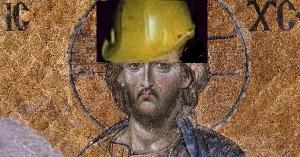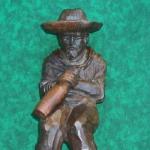Was Jesus a carpenter, or a builder? Was he actually a construction worker?
Jesus’ father Joseph is commonly identified as being a “carpenter,” a word that implies that Jesus and his father worked with wood for a career. The term tektōn is found only twice in the New Testament, in a doubly-attested quote where Jesus is referred to as either “the carpenter” (Mark 6:3) or “the son of the carpenter” (Matthew 13:55). Further investigation, however, will show that tektōn is a generic word for “builder,” in the same sense that architektōn (= “architect”) means “chief builder” (1 Corinthians 3:10).

The Liddell-Scott lexicon of ancient Greek states that the use of tektōn to mean anything other than “carpenter” is relatively rare. But the Greek Old Testament (where tektōn is used 30 times) is a treasure trove of examples of tektōn being used in such ways. The Greek version often differentiates between a crafter “of wood,” a crafter “of stone,” or a crafter “of iron”. So in 1 Samuel 13:19, a “tektōn of iron” is a “blacksmith” (see also Isaiah 44:12). And in 2 Samuel 5:11, the “carpenters and masons” sent to David by King Hiram are “tektonas of wood” and “tektonas of stone,” while in 1 Kings 7:14, a half-Tyrian artisan named Hiram hired by Solomon is a “tektōn of bronze.” But in some passages, the tektones are distinguished from the “stonecutters” (latomoi – Ezra 3:7) and/or the “builders” (oikodomoi – 2 Chronicles 34:11). However, in each of these examples, there are specific Hebrew terms that explain the use of different Greek terms; the Hebrew charash (generic “craftsman”) is consistently translated by tektōn in the Greek, as seen in 2 Chronicles 34:11. Indeed, in Ezra 3:7, both words are translated into Latin as cementarius (a worker in cement, a mason).
Hosea 8:6 says of the golden calf in Samaria, “A tektōn made it; it is not God.” If this idol was solid metal rather than a gold-plated wood carving, then a tektōn does not necessarily work with a saw, hammer, and nails. Hosea 13:2 also speaks of those who construct molten images of silver as tektones. Likewise, Isaiah 40:19 speaks of a tektōn “casting” or “pouring” a molten idol, while in the very next verse a tektōn is crafting an idol of wood.
Josephus uses the plural of tektōn to refer to those who constructed Moses’ tabernacle (Antiquities 3:204). In his descriptions of the construction of Solomon’s and Herod’s temples, like the accounts in Kings and Chronicles, Josephus distinguishes between stonecutters and tektonas, with no indication whether the tektones are involved in the stone-laying process, or are only involved in woodwork. In Jewish War 3:78, Josephus calls the men who construct the Roman military camps tektones. And in Jewish War 3:171, Josephus tells that he ordered his tektonas to build a (presumably) stone fortification wall higher in order to defend his city (3:173 and 5:275 also refer to them building city walls).
Do these uses of tektōn throw more light on what Jesus and his earthly father did for a living? They certainly broaden the possibilities. They tell us that Jesus had muscle and technical skill. If not for the fact that Joseph and Mary offer the lowest-price option for their Temple sacrifice when Jesus is born, we might think that their family belonged to the upper middle class.
Later on, near the end of the first century AD, according to the historian Eusebius, Jesus’ nephews appear before the emperor Domitian, who is afraid that because that because these Christian leaders are descendants of David, they may try to rebel and set up their own kingdom. When he examines their hands, however, and see that they are rough from manual labor, and that these men had only a modest amount of land, he released them as being no danger to the empire. This is the only other clue we have that Jesus and his family could be classified as “blue collar.”
We may compare Jesus’ pre-ministry career with the professions held by other rabbis in Jesus’ day. We are told that Shammai was also a carpenter. Hillel was a day laborer. Others were shoemakers, shopkeepers, and professional writers. Saul of Tarsus was a tentmaker. But it does not appear that Jesus practiced his profession once he left Nazareth to proclaim God’s word; he appears to have relied on the hospitality of those who wished to benefit from his ministry. Luke 8:1-3 names some women of wealth who followed him and provided for him. This is not out of line with the practice of the above-named rabbis, who often could not earn enough by part-time labor to keep themselves out of poverty, and who survived only because of the additional generosity of others.
It is because the term tektōn is better translated “builder” rather than “carpenter” that I have rewritten the children’s TV theme song “Bob the Builder” and re-titled it “Christ the Builder.” Followers of Christ: hard hat, anyone?















